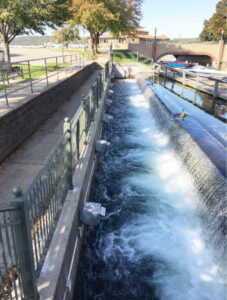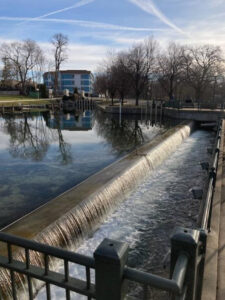The object and purpose of the Geneva Lake Level Corporation shall be to establish, maintain, and control the water level of Geneva Lake in Walworth Count, Wisconsin, to protect the riparian interests of the property owners upon the lake, to keep and maintain the dam and spillway at the foot of Geneva Lake, to cooperate with the duties of protecting the lake against water pollution, and to further conservation of the water resource to the end that the lake may serve the enjoyment and benefit of the people.
Geneva Lake was formed some 10,000 years ago as the result of glacial action, which created the lake basin and sculpted the landscape. The earlier of these glaciers created what is known as the “Troy Valley,” a depression running generally southwest from Troy, Wisconsin, through Lyons and then westward through what is today the City of Lake Geneva toward Beloit. This glacier subsequentlyreceded and later advanced again, this time carrying with it vast quantities of gravel that were deposited as hills or ”terminal moraines.
“These gravel moraines closed off the Troy valley in various places, particularly in the vicinity of Fontana creating a vast natural dam across the Troy Valley and forming the western end of Geneva Lake
and to a lesser extend closing and forming the eastern end of the lake. Henceforth, the basin that would become Geneva Lakedrained toward the east through the White River to the Fox River (Note 1).
Because of these glacial antecedents, the lake is very deep for Wisconsin lakes, reaching 140 feet in the region west of the narrows, and 60 feet in the region east of the narrows, with a surface area exceeding 5,500 acres.
European-Americans first discovered the lake in 1831 when an Army party, under the command of Major John Kinzie, was travelling along Indian trails from Fort Dearborn in Chicago to Fort Winnebago near
what is today Portage, Wisconsin. The trail led through the Pottawatomie Indian village located on a plateau near the seven ceremonial pools at the western end of the lake. There is a bronze marker located on the south shore lake path about 1/4 mile east of the Abbey Harbor commemorating the place where the Kinzie party first viewed the lake.
In July, 1835, four years after the Major Kinzie’s Military expedition first looked upon Lake Geneva on their way to Fort Winnebago, the U.S. government sent surveyor John Brink through the area to lay out section and township lines in preparation for opening the territory for settlement. Seeing the water power potential possessed by the lake’s outflow, Brink decided to build a dam and mill on the lake outflow for himself. He later asserted that he had marked off the area he wanted to claim by chopping down trees and carving his name on tree trunks around the perimeter of the property which was the custom at that time. In February, 1836, before Brink could return to build his mill, an itinerant frontiersman named Christopher Payne came to the area having learned independently from a French trader of the lake’s water power. With the help of Robert Warren, an experienced millwright, Payne began to build his own dam and sawmill on the same site, located where the Geneva History Museum is located today. Payne later claimed that he saw no evidence on the site of Brink’s prior claim. According to James Simmons’ book, Annals of Lake Geneva Wisconsin 1835-1897, after Brink returned and found Payne’s dam well advanced, many months of often violent confrontation occurred. At one point Payne was kidnapped, put on a wagon, and taken back to Illinois. Brink eventually agreed to sell his interest to Payne for $2000 and left the area. In December, 1836, Payne completed the dam, thereby raising the level of the lake seven feet, and began operating his sawmill. In 1837, Payne sold his interest in the dam and mill to the Maxwell brothers and moved to Duck Lake, known today as Como Lake, where he staked out a claim to that lake’s water power and built a dam that he operated successfully for many years.
By 1890, the Lake Geneva dam and mill had been sold several times accompanied by changes in the mill to process other commodities such as grist and wool instead of cutting lumber in response to changes in the needs of the local economy. In the meantime, Lake Geneva had become populated by many new comers who owned steam yachts as well as more than a dozen commercial boat operators. They were generally distressed by fluctuations in the lake level as much as three or four feet depending on the mill’s need for water. This changing lake level interfered badly with navigation around the lake.
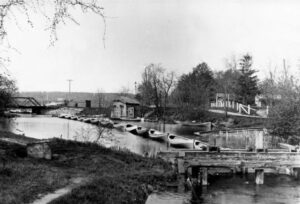
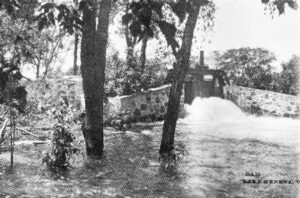
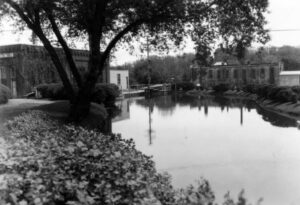
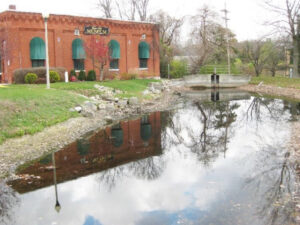
In the spring of 1894, Henry H. Porter, a Chicago railroad investor and steel company executive, learned fortuitously that the Lake Geneva mill property and dam at the head waters of the White River together with the water rights were for sale. Porter immediately perceived that it would be in the best interests of all the lake shore property owners and village residents if the water outflow could be better controlled thereby maintaining a consistent lake level. He promptly purchased the property and the water rights, providing the purchase money himself.
Appreciating the significance of Porter’s purchase, other lake shore and community residents joined him in forming a corporation with the rather ponderous name of The Lake Geneva Water Power & Lake Level Protection Company. Shares of stock were offered publicly and about twenty individuals purchased stock in the company thereby enabling the repayment of Porter’s advance and providing working capital.
The names of the first directors of the corporation were Henry H. Porter, Samuel W. Allerton, Levi Z. Leiter, Frank R. Chandler, and Wiley S. McCrea. Other individuals who bought shares were Samuel H. Wheeler, John S. Cooke, Catharine Seipp, Julian S. Rumsey, Theis J. Lefens, William J. Chalmers, Harrison S. Rich, Bernard Eckhart, Charles H. Wacker, John C. Hately, Mary D. Sturges, Henry Strohy, Frances R. Lackner, H. J. Evans, John M. Smyth, Martin A. Ryerson, and Geoge Braun.
The business purpose of the corporation was described as “… maintaining and operating a water power mill, improving and leasing lands, and regulating the water level of Lake Geneva.” According to Paul Jenkins in The Book of Lake Geneva, (the dam) “…..has ever since kept the water at its present height. As a result, the lake is today one-eleventh larger in total area than it was before the dam was built.”
In the spring of 1895, the Company razed the mill and in August authorized construction of a new dam using rocks and wooden timbers. In 1896, the company installed an electric dynamo and in 1898, the company worked with the newly formed Equitable Light Company to provide electricity to nearby local businesses. In July, 1909, the directors authorized construction of a concrete overflow spillway and a system of gates adjacent to the spillway to regulate the water flow and further stabilize the level of the lake. These water works were located in swamp land that later became Flat Iron Park.
In 1959, the directors determined that it would be in the best interest of the lake community to convert the company to a not-for-profit public corporation. Accordingly, it was reorganized as the Geneva Lake Level Corporation and received Internal Revenue Service recognition as a 501(c)3 charitable corporation. In 2002, with the support of the four surrounding municipalities, the spillway and water control gates were rebuilt. Walkways and railings were added and lights were installed to make the area more attractive.
Since 1895, almost 130 years ago, the original directors of the Lake Geneva Water Power & Lake Level Protection Company and their public-spirited successors of the Geneva Lake Level Corporation, have maintained the dam and the associated water control facilities, effectively stabilizing the level of Lake Geneva in the best interests of the riparian property owners, the surrounding municipalities, and the public.
